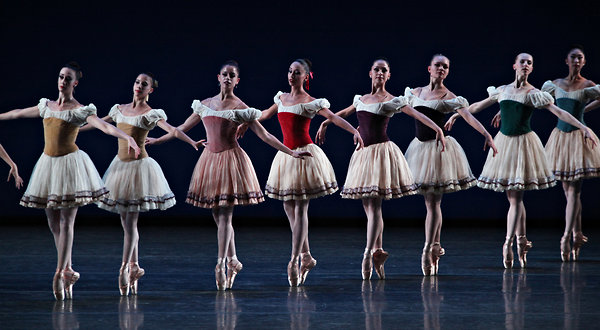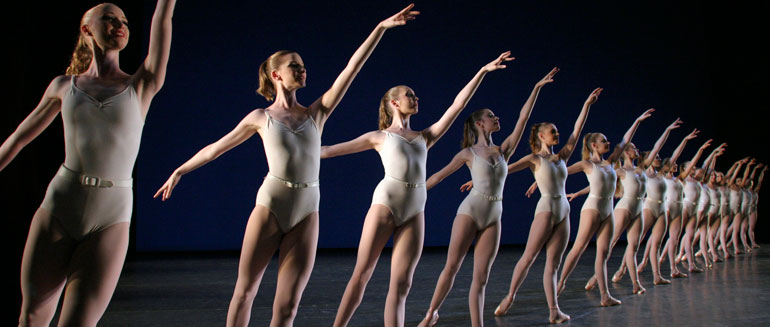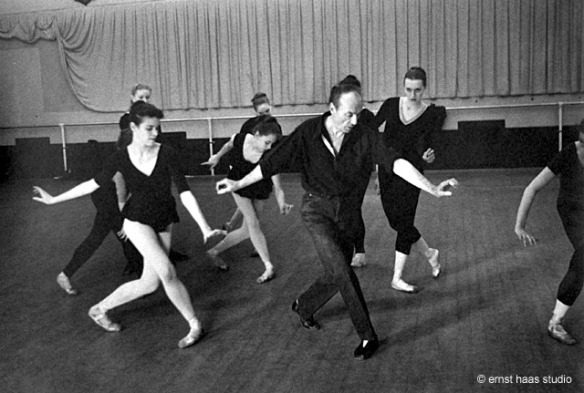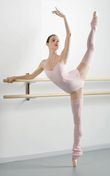Balanchine’s Harlequinade (1965) cycles through our rep only rarely, and it has been absent for over a decade. I was an Alouette when it last ran, and since the birds don’t appear in Act I, I had never seen it before. So I sat in the audience and watched the dress rehearsal. I was surprised to discover a cribbed verbatim sequence in the children’s choreography. The little girls who play the mini-Harlequins attack Columbine’s dopey suitor Léandre with the same choreography that the adult fairies in Balanchine’s A Midsummer Night’s Dream (1962) employ to attack Puck. Both groups wield sticks, encircle their prey, and go on the offensive with attitude sauté chassé drives. I guess when you have nailed a balletic stick assault you have nowhere else to go with it!
But this isn’t the only bit of recycling going on in Harlequinade. There are the Rouben Ter-Arutunian sets which were originally used for New York City Opera’s production of Cinderella. The plot is
Anyway, the other pilfered stretch of choreography was pointed out to me by my La Valse partner Andrew Scordato this afternoon. The first pas de deux couple in Balanchine’s La Valse does a sequence of chassé saut de basques straight out of the Waltz of the Flowers. I had never noticed! But here have been numerous examples of borrowing in the rep this season. One of my favorite instances was in the program that paired Balanchine’s Concerto Barocco with Jerome Robbins’s Goldberg Variations. In the first section of Goldberg, Robbins quotes the iconic “chicken step” performed by the female leads in Barocco in a dance for a male quartet. It is an overt reference done in homage to Balanchine, but it also wittily subverts gender roles. Robbins’s choreographic direct quote also demonstrates his good ear: for Bach was certainly recycling a passage of his own in this moment!
It seems that composers salvage musical phrases often, and Tchaikovsky is particularly eco-friendly. Back in December, Christine Redpath, Cameron Grant, (ballet mistress and the NYCB orchestra pianist, respectively) and I were discussing how one finds new snippets of quoted material in the Nutcracker music every year. This year’s revelation: there are shades of the Sugar Plum’s solo in the counterpoint in the Snow Scene. Solmon Volkov’s book Balanchine’s Tchaikovsky lists several more thefts: the Arabian solo is not Arabic at all; its melody is based upon a Georgian lullaby. The overture is after Mozart. The Waltz of the Flowers is close to Tchaikovsky’s own waltz from Onegin. The Grandfather’s Dance is a traditional German tune. When Balanchine needed some entr’acte music (for the set change between the Party Scene and the Battle Scene), he simply cut-and-paste an unused violin solo from Tchaikovsky’s Sleeping Beauty into the mix. It meshes seamlessly because Tchaikovsky had self-recycled it in the Nutcracker tree-growing music anyway!
Sometimes choreographers steal from themselves when they like a particular phrase, or when they get strapped for time. When I first learned the finale of Le Baiser de la Fée many years ago I exclaimed to ballet mistress Rosemary Dunleavy: “these are all the same steps that the five soloist couples do in Symphony in Three!” She laughed and replied in the affirmative, explaining that Baiser and Symphony in Three Movements were made at the same time for the Stravinsky Festival in 1972. Apparently, Balanchine was running like a madman back and forth between studios and projects. It is no wonder that the two pieces’ choreography bled together. What is amazing is that the ballets look nothing alike--Baiser is a riff on Giselle done in peasant skirts and corsets; Symphony in Three is an angular black and white ballet done with cheerleader ponytails. I doubt that audience members would even notice the heavy recycling if they were performed back to back on the same program!
Ballets come and go in the rep, and in many cases they disappear altogether. Oftentimes, a ballet that is being referenced in a subsequent piece becomes eclipsed in popularity by the copy. For example, there is a section in Robbins’s Opus 19/The Dreamer (1979) that we call “Goldberg” because it borrows sixteen counts of material directly from the finale of Goldberg (which was made in 1971). It is a good stopping point in rehearsals, and it is marked in the score so that during practices the ballet mistresses Susan Hendl and Lisa Jackson will often order us to “take it from Goldberg.” What is funny is that Opus is performed far more often than Goldberg is, and during the rehearsals for the latter ballet last month some of the younger dancers were asking, “isn’t this from Opus?” Maybe we should reverse the markings in the scores.
In the Volkov book Balanchine freely cops to his penchant for recycling. I love his explanation because it highlights the circularity of art and ideas in such a playful yet honest way. I think it’s worth quoting at length—since copying is the theme of this post after all! I leave you with Balanchine’s words:
“I once invented millions of different things, and now I sometimes think, why should that be lost? Why should I come up with new ideas when I have so many in reserve? Moreover, thirty or forty years ago I was young, and it’s easier to choreograph when you’re younger. I could demonstrate a lot of things then that I no longer can. I could lift a ballerina, for instance. So now I recall one of my old tricks and I think, ah! I’ll put it in a new ballet. Many of my recent works have things that I came up with when I was eighteen. But perhaps I did not quite understand what to do with all those ideas, while now I can utilize them wisely.”




 RSS Feed
RSS Feed